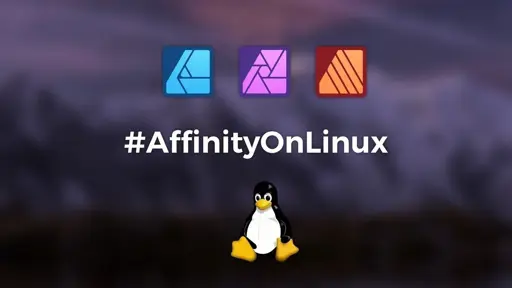Bring the Affinity Suite to Linux - #AffinityOnLinux
The Affinity Suite is great, but I’m suspicious of its acquisition by Canva—I’m afraid their solution to “bringing the suite to Linux” will be turning it into a web service.
A subscription web service
If we all spent that money on gimp, scribus and inkscape, they would be so much better in just 2 years.
The thing preventing me from using Gimp is the terrible UI and UX. And that situation hasn’t really changed very much in the last 15 years, either. I’m getting the feeling that Gimp is stuck as it is because the devs and current users want it like that.
I don’t do much editing (certainly not fancy stuff with heavy use of all the tools), but there is a pretty good mod/patch PhotoGIMP that makes it present similar to Photoshop. It isn’t that old GIMP-shop one that might have malware. Doesn’t fix the missing stuff that power-users need, so no go for many of them. But the UI is much better than the main version of GIMP. Just have to apply the mod/patch after installing GIMP.
PhotoGIMP is the same jank, just taped together in different locations instead. It’s very slightly better, but the actual tools and how you use them are the same. The problem seems to be that Gimp (and all the tools in it) is designed by developers.
Good to know that you actually give options a try (every now and then I try Photoshop to see how it works and new things). So many people will just hate on things just because they just hear that they are bad. One of my friends does photography and hates how Photoshop being a subscription costs so much. But refuses to bother checking-in on GIMP or other options. Even Lightroom alts are deemed not worth it just from muscle memory it seems. Which I do at least understand, but even just checking on options can mean having fall-backs if suddenly needing them. I doubt Adobe will just go away, but they can always make costs higher and higher which price people out.
It would be good if more UI/UX minded folks that actually use Photoshop/Lightroom but hate Adobe’s sub models were to help out. Even just giving good input and follow-up with why or how those things could work is a starting point. Devs and creatives need each other for making projects/products like GIMP into options that more people would use for real.
Good to know that you actually give options a try
I’m cheap and have used GIMP, Scribus, Inkscape and Paint.NET for professional work at my job (where I’m basically our one-man marketing and web department). So I’ve had to “make do” with a wide range of free software for a long time. And I may or may not have used a cracked Photoshop, InDesign and Illustrator at home, also.
But man, I gotta say the quality and efficiency of my work has improved 10-fold after I bought the Affinity suite (no subscription, and its license allows me to use it commercially too, even though I bought it personally - I love that!)
You have a good point in needing to try other things, but there’s also a reasonable need to stick with the workflow that works for you.
Have you tried 3.0? Genuine question because I haven’t and the UI looked a lot better than earlier versions. But if it’s still janky…
I haven’t actually used 3.0 yet, but from all the screenshots I’ve seen, it looks basically the same.
Anyone who has, I have a question: Can you draw simple primitive shapes non-destructively yet (without having to open another plugin panel, select something in a very long dropdown, and filling in a bunch of parameter fields)?
deleted by creator
I am actually producing PDF/X-4 print-ready stuff with Inkscape, ghostscript and Scribus. I even have TrimBoxes and proper CMYK.
But it involves many manual steps, especially overprinting for the K color channel does not work and I need to adjust every polygon and vectorized text manually.
I whish it would be possible all in one tool. I can afford the time, because it is only a hobby. If it would be professional the extra steps involved make it not good enough.
I use Ghostscript for postprocessing the PDF files. What do yo I use to add a color profile for example?
ghostcript can add a color profile, too. I use the regular ISO coated v2 (without the 300%). This is just a step to not do all things in Scribus by hand and make sure colors are not out of gamut.
I don’t now the command line from the top of my head. Just ping me again, so when I am on my computer I can send the complete ghostscript cli line that currently works for me.
The final profile is set up by Scribus, where I have set it to the ISO coated with 300%. Ideally I would like to have less steps in the chain, so that a change in the Inkscape-source involves less manually steps. One can dream of it. (:
Here I am again.
I’ve been fantasizing of making a simple GS GUI.
Finally I found the time to write down, how I use Ghostscript:
gs \ -sDEVICE=pdfwrite \ -o /output/gs_file.pdf \ -dPDFSETTINGS=/prepress \ -sProcessColorModel=DeviceCMYK \ -sDefaultCMYKProfile=/path/to/ISOcoated_v2_eci.icc \ -sColorConversionStrategy=CMYK \ source/file.pdf \ -fI don’t now which of
ProcessColorModelorColorConversionStrategyis the important one. I kept both and did not bother to try to omit one of them.-dPDFSETTINGS=/prepressmakes sure that embedded bitmaps are in 300dpi and I think-fprevents Ghostscript staying in interactive mode after all pages have been finished.
Agree.
GIMP had almost 25 years to be acceptable. It is still awful to use. Serif’s Affinity was awesome within half a decade.
Must be something with free software that just sucks.
The something that sucks is lack of money. Paying developers to do work definitely helps. It’s unfair to level unconstructive critique at the end result when it hasn’t ever had the same opportunity to thrive that the paid software you’re comparing it to had.
Serif produced a nice software suite by paying developers. They got that money from investors who made it by exploiting people (like every corporation) and then exploited their workers and customers in turn. While this resulted in a relatively nicer alternative to Adobe shit, it still isn’t ideal.
Imagine if GIMP, Scribus, Inkscape, and Krita all had the kind of financial support that corporations do. Blender and the community supporting them are figuring it out to some extent, and now Blender has essentially either matched or eclipsed the corporate competition. This is absolutely possible for other FOSS software, but we the community need to be there for them financially too.
Paying developers to do work definitely helps.
The lead developer of GIMP currently receives about €1,200 per month in donations via PayPal, and the entire GIMP project receives even more via LiberaPay. Admittedly, this is not really ‘their paid job’.
But now I’ve had to listen to open source fans for over twenty years saying that open source software shows that you don’t need a lot of money, just a lot of volunteers to do much better work together. I don’t doubt that (for example) Blender is excellent software, donations or not (they didn’t always exist). But why does this concept fail when it comes to image editing software?
Yeah it’s definitely not just a money thing. Some projects and communities like Gimp have been historically dismissive of design as a concept. Where as Blender has not despite starting in a bad place design wise. It’s come so far.
Gimp needs a philosophy change more than anything but it will never happen with half the community screaming “it’s just different” anytime someone has valid criticisms. Design literacy is as real as code literacy. Thankfully there seems to be lots of other graphic projects these days that might fill the void.
Which one could replace GIMP? I might be curious. I saw a few development projects, but I don’t know their current state.
GIMP etc are not developed by the target consumers is the real problem. affinity exists literally to capitalize on adobe going subscription and their entire effort has been to basically make adobe-but-better at a reasonable end user cost to convert users. As a professional designer, I have successfully migrated to Affinity after years of waiting for GIMP and others to match adobe offering. Even now, I would still use Photopea over GIMP. If one guy can make Photopea in his spare time, then what is stopping the GIMP team from doing the same while being paid? I’ll tell you; because they have no idea what a professional actually needs.
If there was a Publisher (InDesign) and Designer (Illustrator) equivalent just like Photopea - my life would be infinitely better because I’ve long since given up hope on Inkscape etc. I could finally breathe as i leave Windows forever. Sadly, best the world is willing to give me is fucking canva, and now those assholes own Affinity - so in the end, i’m still stuck between a rock and a hard place/
Oh no, when did they get bought by those ghouls?
Awh fuck. I bought a lifetime thing for the whole Affinity studio like two years ago when it was on sale. Is there a decent alternative to Affinity? I would rather not go back to GIMP for images, just cos the UI/UX isn’t so smooth!
The current version of Affinity is great and will continue to work forever—there’s no need to switch to an alternative if you’re already using it. I just don’t have much hope for its future development.
One of their pledges when they were bought was to always have a standalone product to buy so people don’t have to do subscriptions.
That’s good of them. We’ll see what their Canva overlords think of those nice intentions 🫡
Its moot because Affinity have already said they will not, not ever.
https://forum.affinity.serif.com/index.php?/topic/98932-faq-affinity-on-linux/
They didn’t say they never will. They don’t have plans for it, but they won’t rule it out.
We won’t rule out making a Linux version of Affinity in the future if the right Linux distro comes along with a reliable deployment platform that will allow us to recoup our development cost for the Linux version.
I guess they could use Flatpaks here if they don’t want to deal with packaging it for every distro.
I’ve also seen Serif saying that they won’t. It was someone else that linked it. I have tried to find the link again but could not and I’m too tired and sick to keep looking. The TL;DR was that they tend to be good at stringing people along but they’ve definitively said its not on their roadmap, won’t be added and supporting Affinity on Linux would be too expensive/difficult.
Canva has little financial reason to invest in Linux users either.
Enshittification also adds to making it incredibly unlikely.
People have been begging Adobe to port to Linux or at least make their products work with WINE for more than a decade now to no avail and Adobe, unlike Serif, has the budget to do so.
But surely this petition with nearly 400 signatures will convince them there’s a business case for supporting Linux!
what is it?
Adobe alternative
It’s a professional-grade graphic design software.
I’ve always been surprised affinity isn’t on linux I would think people looking for alternatives to adobe would also be looking for alternatives to windows so it makes sense to put them together.
There is a wine branch that can run Affinity just search for it
Question, are you running it? I got really hopeful about it but feedback I read said it wasn’t very good. It worked, technically, but was buggy making it less than ideal. I forget all the details but it was enough to make me not want to even try it.
Yea I got it working. From what I see everything works except it doesn’t remember your settings. But I can live with that.
I tried multiple times but i ended up loading it in a vbox 🤷♂️ since the Canva acquisition I started getting used with gimp, krita and inkscape. I have zero hopes for this.
That’s what I do. There’s few programs I still need windows for so I just spin up a VM for them.
How’s the gimp/krita/inkscape transition going? I’ve used Gimp and Inkscape, and they are fine tools, but I don’t think they are Affinity level yet. Though admittedly it’s been a few years since I last touched them.
Yea I pretty much do the same, even tho I still need to figure it out the pass-through for the gpu. And also to be clean, as much as I would love to, gimp and inkscape are not ready for professional use I think. Krita is nice but not very useful to be. Instead kdenlive really shames premiere and AF, i was blown away.
OK thanks for confirming. I’ll stick with Affinity for now. I didn’t know abit kdenlive, something to check out. I’m still getting use to davinci resolve as it is.
If a program insists on Windows, it is instantly deemed incompatible with my operating parameters and fails my system requirements…












